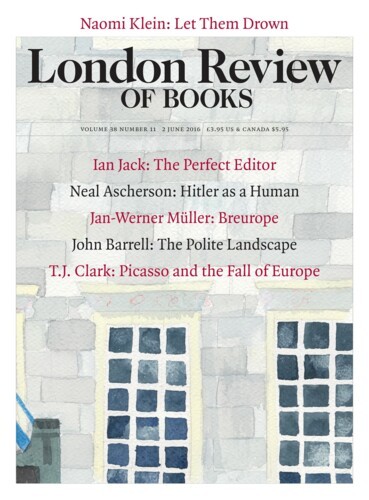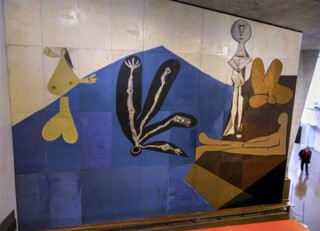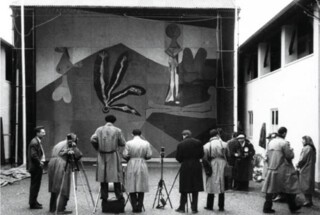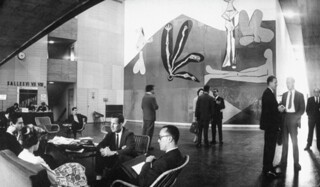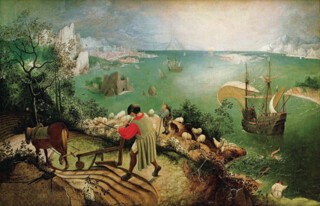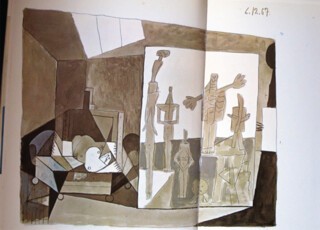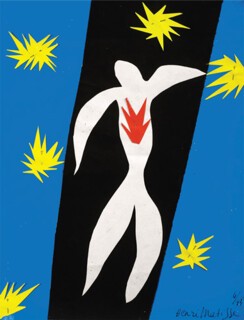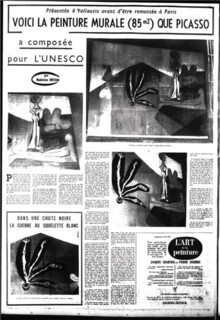A vision of Europe in 1950:
Two world wars in one generation, separated by an uninterrupted chain of local wars and revolutions, followed by no peace treaty for the vanquished and no respite for the victor, have ended in the anticipation of a third world war between the two remaining world powers. This moment of anticipation is like the calm that settles after all hopes have died. We no longer hope for an eventual restoration of the old world order with all its traditions, or for the reintegration of the masses of five continents who have been thrown into a chaos produced by the violence of wars and revolutions and the growing decay of all that has still been spared. Under the most diverse conditions … we watch the development of the same phenomena – homelessness on an unprecedented scale, rootlessness to an unprecedented depth …
It is as though mankind had divided itself between those who believe in human omnipotence (who think that everything is possible if one knows how to organise masses for it) and those for whom powerlessness has become the major experience of their lives.
On the level of historical insight and political thought there prevails an ill-defined, general agreement that the essential structure of all civilisations is at breaking point. Although it may seem better preserved in some parts of the world than in others, it can nowhere provide the guidance to the possibilities of the century, or an adequate response to its horrors.
The seer is Hannah Arendt, in the 1950 preface to The Origins of Totalitarianism. When she wrote a new preface to the book in 1966, and looked back for a moment at her original judgment, she was a touch apologetic. The Origins had been drafted between 1945 and 1949, and in retrospect it registered, she had come to feel, as a first effort to understand what had happened in the opening half of the 20th century, ‘not yet sine ira et studio, still in grief and sorrow and, hence, with a tendency to lament, but no longer in speechless outrage and impotent horror’. ‘I left my original preface in the present edition in order to indicate the mood of those years.’
I understand her unease. Already by the mid-1960s, the moment of The Origins of Totalitarianism’s second edition, the tone and even the substance of her 1950 reckoning with fascism and Stalinism had a period flavour. The world – or at least, the world of European and European-in-exile intellectuals – had decided that the 20th century’s long catastrophe was over. Many thought that 1962, the year of the Cuban Missile Crisis, had marked its ending. And whatever crisis of civilisation had succeeded the earlier terrible catastrophe – Arendt and her friends were far from certain how to characterise the new situation, and certainly not inclined necessarily to see it as a respite from ongoing decay and powerlessness at the level of civil society – it could no longer be written about (or depicted) in epic terms. The fall of Europe had happened, tens of millions had perished, but the fall of Europe had not proved a new fall of Troy. After it had not come the savage god. Maybe ‘the essential structure of civilisation’ had broken; but the breakage, in the years after 1950, had failed to give rise to a new holocaust or a final nuclear funeral pyre. In place of the banality of evil had arrived the banality of Mutually Assured Destruction.
‘Two world wars in one generation, separated by an uninterrupted chain of local wars and revolutions’: perhaps it goes without saying that for Arendt’s generation the revolution that summed up the previous horror – staging, as it had seemed to, the essential combat between fascism and communism with special concentrated violence, and drawing into it left and right partisans from across the world – was the Civil War in Spain. It was, for them, the epic event of the mid-20th century. Picasso’s Guernica had given it appropriate, unforgettable form.
The painting still does, of course. Arendt may have been right to feel a twinge of embarrassment at the tragic, exalted, ‘catastrophist’ tone of her 1950 preface, and to have thought by 1966 that the fate of mass societies in the late 20th century needed to be approached in a different key. But her thinking has not carried the day. The late 20th century, she argued, would only truly confront itself in the mirror if it recognised that the battle for heaven on earth (the classless society, the thousand years of the purified race) was over. It had given way (this is Arendt’s implication) to a form of ‘mock-epic’ or dismal comedy – still bloodstained and disoriented, but divested, by the evidence of Auschwitz and the Gulag, of the deadly dream that everything is possible. And it is this post-epic reality we should now learn to live with, she believed – maybe even to oppose. We shall only do this, her 1966 preface says, if we manage to look back on the hell of the totalitarian period with thorough bemused disillusion. We have to learn how not to allow the earlier 20th century to stand for the human condition. We have to detach ourselves from its myth.
But this has proved impossible. Guernica lives on. Or to put it more carefully: what is striking about so many 21st-century societies, especially those involved directly in the wars and revolutions Arendt had in mind, is the fact that they go on stubbornly living – at the level of myth, of national self-consciousness, of imagined past and present – in the shadow of an already distant past. It is their fantasy relation to the struggle of fascism and communism that continues to give them or rob them of their identity. Germany remains the prime example, in its interminable double attachment to (its guilt at and caricature of) the pasts of Nazism and the Stalinist ‘East’. Russia – with its neo-Bolshevik hyper-nationalism – is the paranoid case of entrapment for ever in the moment of Stalingrad. Britain’s endless replaying of its finest hour stands in the way (as it is meant to) of any real reckoning with the past of empire.* (How far, we might ask, has the UK’s sense of its ‘role in the world’ progressed – been inflected imaginatively, mimetically, ethically – since the ironies of Kipling and Conrad?)
Picasso’s Fall of Icarus, done in 1958, is a defining and appalling statement of Arendt’s post-epic perspective. It aims to put the era of Guernica behind it. And it does so in a context that lies at the heart of the postwar, ‘international community’ reality of the 1950s: the just finished headquarters of the United Nations Educational Scientific and Cultural Organisation in Paris. Icarus was commissioned for the hallway of Unesco’s Bâtiment des Conférences, and first shown to the public there on 3 November 1958, the moment of the new building’s inauguration.
Picasso’s proposal – his vision of the form to be taken by history painting in a post-Guernica age – has never been much liked or understood. The literature on the artist largely leaves it to one side: the Communist pantomime of his earlier Massacre in Korea, or the exacerbated repeat of Guernica in the Temple of Peace at Vallauris, are given more sympathetic attention. No one – Picasso included – has ever had a firm idea of what the Unesco mural was of. Unesco itself, in the literature produced for the inauguration, said it showed ‘les forces de la vie et de l’esprit triomphant du mal’. Maurice Thorez, leader of the French Communist Party in the 1950s, and a regular visitor to his most famous party member in Vallauris – Picasso and he seem to have had a genuine friendship – noted in his diary that the mural showed ‘le triomphe de la paix sur les forces de la guerre’. Thorez had been present at the first unveiling of the mural in Vallauris in March 1958, but it seems doubtful that his title conveyed Picasso’s intention accurately. When Georges Salles – old friend of Picasso, scholar of Asian art, by 1958 head of the French museum establishment – called the scene ‘La chute d’Icare’ in a speech at the painting’s installation in Paris a few months later, it was unclear to his audience if he was acting with Picasso’s sanction. Salles, we know now, had been at the Vallauris launch and suggested a title then: ‘L’Icare des ténèbres’. A journalist for Radio Geneva had asked Picasso directly at the time: ‘Maître, pensez-vous vraiment que ce soit l’Icare des ténèbres?’ To which Picasso replied:
Yes, I find that George Salles’s thing is accurate, more or less – because a painter paints and doesn’t write – it’s more or less what I wanted to say.
It went on for months and months, and little by little it was transformed without me even knowing where I was going, d’you follow? – It began in a studio where there were pictures, it was my studio where I was in the process of painting, you understand? – And little by little the picture ate up the studio, there was nothing left but the picture, which said – which expressed – things I was master of but not acting of my own free will [des choses dont je suis le maître mais pas volontairement l’acteur].
The interviewer turned to Jean Cocteau and asked for his impressions. Cocteau’s reply is indicative: he seems to be struggling between the epic and post-epic frames of reference that the new mural put in question, hanging onto the possibility of history and tragedy, but glimpsing (his voice fading into silence as he tries to articulate the thought) a future with no such frame:
Well, for me, it’s the curtain that rises on an epoch, or falls on an epoch, that’s for the public to decide. We have lived a tragic epoch, we are going to live another, it’s either the curtain that falls on a tragic epoch, or the curtain that rises on … the curtain for the prologue to another tragic epoch. But there is a great tragedy in his fresco. It’s a diplodocus, it’s the last terrible animal from an epoch we have just traversed, which moreover was very great, but very terrible.
And Cocteau is followed by Salles himself, whose reinterpretation of his own Icarus suggestion is a masterpiece of ‘international community’ waffle:
On the wall, what did I see? I saw that Unesco had at last found its symbol. At the heart of Unesco, at the heart of the new building … we’ll be able to see the forces of light defeat the forces of darkness. We shall see the forces of peace defeat the forces of death. [This echoes the Thorez reading, but there is worse to come.] We’ll see all this accomplished, thanks to Picasso’s genial production, and alongside this combat, which is great like an antique myth, we see a pacified humanity which is present, on the shores of the infinite, at the accomplishment of its destiny [on voit une humanité pacifiée qui assiste sur la rive de l’infinie à l’accomplissement de son destin].
We would do well , I think, to retreat from Salles’s shameless récuperation and put our trust in what he said before the microphones were switched on: the three-word title he seems to have come up with first in Vallauris, cobbled together from half-memories of Les Fleurs du mal. L’Icare des ténèbres, as the interviewer called it. Both elements of the idea, if we put them back in their Baudelairean context, seem close – in tone and even intention – to Picasso’s reworking. First, the two terrible lines from ‘Au lecteur’:
Chaque jour vers l’Enfer nous descendons d’un pas,
Sans horreur, à travers des ténèbres qui puent.
It is the chilling ‘sans horreur’ which seems to catch Picasso’s new tone. And second, the last lines of ‘Les Plaintes d’un Icare’, with their vision of a future – an abyss – that refuses to be named:
Je n’aurai pas l’honneur sublime
De donner mon nom à l’abîme
Qui me servira de tombeau.
The world of Arendt’s new preface is close.
It would be easy, after Salles, to paint a scathing picture of Unesco. There were many such indictments at the time. As early as 1950 Benedetto Croce could be found, in the Manchester Guardian, arguing seriously for the organisation’s disbandment, as a failed experiment overtaken by Cold War duplicities. Even those who (quite reasonably) celebrated the range of good works that Unesco fostered in the world rarely failed to regret the Great Power politics creaking on at its centre.
In 1951, the question of Spanish membership came up, an issue that mattered in particular to Picasso. The US and France were officially opposed; the Franco regime pretended to be indifferent. In the same year Spain refused to allow a Unesco display on human rights to cross the Pyrenees. Garroting of trade unionists in 1950-51 – the pace of executions quickened in the wake of a general strike in Barcelona in the spring of 1951 – ‘aroused scattered headlines’ in the world at large. Picasso had come to the attention of Franco’s Dirección General de Seguridad as early as 1944 (he was supposed to have signed a letter to De Gaulle urging French support for the regime’s opponents); he gave generously to Spanish refugee organisations then and later, and lent his name to various anti-Franco causes. When Spanish membership was broached again in 1952, Camus and others petitioned the director general to veto it. Pablo Casals and Salvador de Madariaga severed connections with Unesco on the issue. Spain joined the body – on a 44 to four vote with seven abstentions – in November.
By the time Picasso accepted the Unesco commission, battle lines in the institution were immoveable. The Soviet bloc campaigned for Peace, the Nato powers for Freedom. Senator McCarthy sent staffers to investigate the loyalty of the US delegation. Had any of them been heard to utter the dread word neocolonialism (about which Unesco members droned on interminably)? ‘Peace’, as a later assistant director general put it, proved ‘the issue which more than any other brought out humbug in Unesco … No other word generated so much loose speech or vague suggestions for projects. One of its later variants was the argument that Unesco should promote a movement towards a “universal humanism” – [a project harking back to] arguments for “a Unesco philosophy” in the organisation’s early days.’ The early days had been dominated by such as Julian Huxley and Joseph Needham. They had not lasted.
The writer just quoted is Richard Hoggart, whose memories of his time in Paris are not fond. The picture he paints of a Unesco General Conference – the kind taking place through the door just to the left of Picasso’s mural – seems relevant.
Meetings usually start late. There is no effective time limit on speeches. Delegates are frequently told that time is short and the list of speakers long … All this usually has little effect … Meanwhile, delegates are moving in and out continually, going for coffee, to telephone, to do business in the corridors or simply to stretch their legs. It is a swirling parade of important people, or of people who were once important, or of people who think they are important.
These are the reminiscences of a disappointed insider, and I do not mean them to represent Picasso’s view. How much the painter knew or cared about Unesco’s on-the-ground reality it is impossible to guess. Probably rather little – the building, after all, was still under construction as he worked. But artists (some artists) are canaries in the mineshaft: they smell the atmosphere of disappointed hopes – ‘the growing decay of all that has been spared’ – before the full form of disillusion has crystallised.
The details of Unesco’s evolution, that is, do not ultimately matter in assessing Picasso’s mural, though often they make for tragicomic reading. (In the 1960s, the Secretariat was instructed to produce anthologies on Tolerance and the Horrors of War. The first could only be printed, after long delays, by an outside publisher, and Unesco refused to put copies on sale – parts of it had not been ‘cleared’. The second never materialised.) Perhaps what is striking, from the vantage of our own Strasbourg-and-Brussels internationalism, is how real the disappointment of the intellectuals continued to be for so long. Unesco, we might say – just because of the urgency and nobility of its aims – was the theatre in which the disintegration of the ‘international community’ could still bring on a shudder. It is this wider disintegration, I feel, that The Fall of Icarus tries to represent. And the mural’s stylistic bizarrerie – the tragicomic strip cartoon idiom Picasso devised for it – could not be more apt.
The work as finally realised is a trapezoid – that is, a vast rectangle with a sloping top edge. It is close on 35 feet wide at the base, and 30 feet high at the left, growing steadily shorter towards the right as it follows the ceiling line. The thing spreads over 970 square feet, painted on forty mahogany panels, weighing around 79 stone. Both size and shape were dictated by the site, on a wall just outside a main auditorium in the Unesco building. The long ground-floor hallway leading toward the mural is crisscrossed, Le Corbusier fashion, by concrete pilotis and walkways, which half-hide the painting till the spectator is almost on top of it. Roland Penrose, by far the most sympathetic of the mural’s historians, may be right when he says of the viewer’s approach:
his movement round these obstacles seems to give movement to the composition itself, in particular to the sinister black shape near the centre of the painting, like the shadow of a man head downwards on which his blanched bones are traced … Our own movement as we emerge from behind the rough concrete pillars creates a new and dramatic relationship between the painting and ourselves.
He may be right … Or he may be struggling, as Cocteau did, to bring the mural back into the realm of Guernica. I think we’d do best to put aside for the moment Penrose’s characterisation of the central Icarus shape – ‘sinister’, he calls it, shadowy, skeletal (all the adjectives are reasonable, but disputable) – and concentrate on his wish for movement and ‘dramatic relationship’.
In front of the mural itself, and moving towards it through the pilotis, I experience no such movement or drama. And I doubt Picasso meant me to. We know that the process of making Icarus was difficult for him: everything, in the realisation of such a public object (he told friends), depended on an evolving understanding of the true shape and size of the pictorial field, and he was worried that in the process of piecemeal assembly – the forty panels, worked on with the help of assistants – he would lose his sense of both parameters, and fail to make his final transfer (from sketch-form to full scale) respond to the reality of the vast flat surface. (No doubt the memory of Guernica emerging from nothing in the room at the Grand-Augustins, changing constantly through the days of its making, responding to the look of its own enormity, was on Picasso’s mind.) I am with Penrose in thinking that Picasso, ‘relying on his ability to imagine [the field] as a whole’, did pull off the final scaling-up for the wall in Unesco headquarters. But as for what the artist intended the shape and size and setting to do to his ‘composition’ (the very word seems a Guernica leftover) – here Penrose and I part company.
A trapezoid – especially one intersected and hemmed in, as Icarus was to be, by great grey concrete horizontals and verticals – is something fundamentally different from a picture rectangle. A picture rectangle, even one blown up to Guernica proportions, enforces the protocols of pictorial looking and feeling. It creates a ‘viewpoint’ – not necessarily a literal, privileged place to take position in front of the painting, but a virtual standpoint from which the picture’s array of things will best make sense and fall into Penrose’s ‘dramatic relationship’ with us. A picture rectangle suggests a perspective on events depicted, whether the space in which the events unfold is plotted explicitly in geometric terms or implied elliptically (even ironically). ‘Perspective’ here means several things: a painted depth into which the viewer is invited to enter imaginatively, a picture plane through which the imaginative entry can take place, and a pondered hierarchy of pictorial incident (a foreground and background, an ‘action’ and a ‘setting’, a centre and periphery), which proposes an order or meaning for the scene portrayed.
A trapezoid – or rather, a trapezoid as Picasso reluctantly came to terms with it – is a picture without a viewpoint. It takes up the normal clues and mechanics of perspective and has them disperse and disintegrate – float back absurdly onto the surface – before our eyes. The orthogonal brown slab of beach or diving board towards bottom right in Icarus is a signature of perspective’s powerlessness against the trapezoid’s flat lack of direction. But so, more grandly and structurally, is the sea’s unstable blue horizon, going off towards a vanishing point in the summer glare; and the inability of that ‘horizon’ to become convincingly any such thing. In this sense, one could say that Picasso took advantage of his panel-by-panel procedure. He came to see that its additive, discontinuous, de-totalising feel was what his understanding of the subject demanded. Or maybe the piecemeal nature of the process reshaped the understanding. Discontinuity across edges became one main carrier of the mural’s strange suspension, or annihilation, of feeling in general. The ludicrous sliced toes of the bather at right are a signature of the new style; and the nowhere-ness of the bather at left – the lack of perceivable relation between her body-parts and the sea they are supposedly floating in – its weirdest achievement.
The photograph of the mural I favour – the one that strikes me as giving the best sense of the thing as it actually functions in Unesco space – is taken from above. We are looking down from one of the concrete walkways, and if we try to get back far enough from the mural to see it all in one piece (well, almost … the eye or camera lens constantly loses hold of one or another corner) we have to accept an oblique, off-centre viewpoint. And this seems appropriate to the trapezoid itself – to the absence of totality (of Penrose-type drama, of epic or tragic depth) that the shape allowed Picasso to come to terms with.
‘Absence of totality’ is, for Picasso, a thing hard won. We know from surviving sketches that the painter’s first ideas for Unesco, jotted down in December 1957, were indoor ones – pictures of a studio, with a model reclining on a couch, confined by four walls and ceiling. (The Guernica commission had begun much the same way: the studio was what Picasso painted while he waited for the world to occur to him. During the latter part of 1957 he had done more than forty variations on Velázquez’s Las Meniñas: the last of them were being finished as the Unesco sketches began.) The world of the beach, which eventually came to dominate Icarus, was already present in Picasso’s first sketchbook treatments, but as a picture: next to the model stood a canvas on an easel, filled with bather totem-figures, and the bathers themselves were doubly mediated, since they were painted equivalents of a set of bronze sculptures the artist had done earlier in the year. The sketchbook worked hard through December and early January to find a way to put model and painting in tighter and tighter Cubist contact. The scene stayed firmly bounded – very much an interior – for several weeks. On Christmas Day 1957 Picasso did a set of small blue and black thumbnails which still insisted on the classic Cubist framework: triangles and quadrilaterals interlocking, solid and void, table, easel, skylight, corner of the room. In some of the sketches from early January bathers in the plural were replaced by a single male standing on a diving board, but what counted, pictorially, was still the to and fro between studio space and picture space – between two kinds of firm containment. (The diver motif was no doubt the original ‘common sense’ idea that gave rise to the falling Icarus in the mural: at one level we might read Picasso’s Unesco painting as a premonition of the Tomb of the Diver discovered at Paestum in 1968.)
It is only after a month and more of experiments that the walls of the room in Picasso’s sketches begin to dissolve; and even when they do – by late January the seaside is decided on – the sketches seem determined, for a week or so, to bring some kind of studio structure out into the open air. In Picasso’s first crude try-outs of his new idea the sea’s horizon line and vanishing point are mobilised so as to tie the array of beachside incident together: orthogonals radiate from a vanishing point, and a further network of triangles attempts to lock the various elements in place. For a while Icarus seems to be heading for a neat triangular hole in the ocean. Segments of coloured paper, hard-edged and crisply discriminated – fragments of Cubist collage – are pinned in changing positions on the surface. The mural might well have ended, by the look of it, as a variant on the kind of tidy ‘perspectival’ beach scene Picasso had painted on camera a few years earlier for Clouzot’s film Le Mystère de Picasso – the kind the artist can be heard describing on the soundtrack, not unreasonably, as ‘très mauvais … extrêmement mauvais’.
My argument, then, is that it was only in the real-size, forty-piece Fall of Icarus that Picasso escaped from Cubism – from the studio, from ‘viewpoint,’ from proximity and tactility, from the whole spatial and figurative world of Guernica – and showed us the world after epic. Two things seem decisive. First, to repeat, there was the eventual effect of the non-square shape on the picture’s deployment of surface and depth. ‘Flatness’ of a new kind emerges, peculiarly piecemeal and lacking in structure, floating the scene’s absurd protagonists apart from one another. It is impossible to know how much Picasso knew or cared, at this point in the 1950s, about ‘American-type’ painting. But The Fall of Icarus has the look, especially from ground level, of a burlesque Barnett Newman with figures added by Matisse.
And then secondly – inescapably – there is the figure of Icarus itself. Where did Icarus come from? Or rather, what was it that provoked the figure’s final transformation from plunging bather (still easily recognisable as such in the sketches) into a free-fall, spider-limbed, semi-transparent ghost – made out of cursory scribbles and slack trails of paint, silhouetted in a black vacuum? The final ghost has nothing to do with the other four figures in the scene: this is Picasso’s key act of anti-composition. Icarus is, in handling and orientation, the strict opposite of his companions’ pinned-on flatness.
Where did Icarus come from? Well, from at least two places. Matisse’s Fall of Icarus, done in the dreadful year 1943, had been assembled from pinned cut papers touched with gouache. It was as close as the artist ever came to an acknowledgment of the world of bomb blast and airborne terror. Picasso could have seen it reproduced in Verve in 1945, or encountered the real thing in Tériade’s collection – presumably at the time he worked with Tériade on his book Le Chant des morts. Put together the bomb-blast stars in Matisse (which may themselves have carried the trace of the exploding light-bulb-incendiary in Guernica) and Icarus’ white-on-black falling body, and you have the bare elements of Picasso’s idea. To these add Bruegel.
I have no doubt that long before Salles produced his Icarus title in March these two versions of the legend – Matisse’s and Bruegel’s – had coalesced in Picasso’s mind. Matisse had been the presiding deity of the Unesco project from the moment (in late January) when the action had shifted from studio to seaside. The tanned figure top right in the mural – pebble, flower, polyp, pin-up, extravagant Saint Tropez sunbather – is a compound and parody of Matisse motifs. The Icarus idea emerged, I believe, from the Matisse matrix. And once it appeared, Bruegel came with it – Picasso burrowed into his library and dreamed over the unavoidable source. What he fixed on, it seems, and set himself the task of repeating, was Bruegel’s grim sense that the tragedy of Icarus had made no difference to the universe it took place in – that in the real world tragedy is an incident, a brief interruption, an agony in a vacuum, to which the idiot onlooker in the mural, staring out at us from his position top right, will never pay heed. Characteristically for Picasso, the response to Bruegel is conceptual and visually specific: Icarus’s weird splayed limbs in the mural (and in the sketch where the figure first materialises) are directly variations on the ‘unnoticeable’ flailing legs of Bruegel’s hero.
Picasso’s Icarus is ‘sinister’, Penrose says – a ‘tattered apparition,’ ‘the shadow of a man head downwards’. But Icarus is also shapeless, weightless, insubstantial, silly, not really present in his black container – not really part of the scene. He may be sinister, he may be a figure of fun. He may stand for disaster, or for some passing evil (or absurdity) averted. Even the Salles/Thorez reading may be right. ‘Peace’ – in all its Unesco blandness – may indeed be basking by the Mediterranean, watching War shot down. We may even be meant to identify (groaning) with Salles’s ‘pacified humanity, which is present, on the shores of the infinite, at the accomplishment of its destiny’. It is worth recalling that in 1958 Picasso was putting the finishing touches to his Vallauris Temple of Peace – painting the temple’s pure-Stalinist end wall, with its cardboard apotheosis of the peace dove. Picasso had intended the temple to have a grand opening ceremony in 1958, but the Vallauris authorities had decided at the last minute that the space was too small for the expected crowd; so the schoolyard unveiling of the Unesco mural may have been a kind of substitute. No doubt Picasso’s painting anticipated the worst that officialdom would make of it. And no doubt that officialdom, for Picasso in 1958, included the Communist Party.
Naturally, Les Lettres françaises, the party’s magazine of art and literature, was given privileged access to the Vallauris debut. In the article accompanying the first photographs of the mural, its correspondent gathered interpretations from selected members of the audience. Salles’s Icarus idea was already solidly in place: the mural was ‘like an antique tragedy in which an “Icarus of the shadows” will fall vanquished by the forces of light, by the human forces of peace’. ‘As for the building workers who put up the metal carcass [Icarus was protected from the weather in Vallauris by a crude scaffold proscenium], this painting made them think “of the H bomb that makes its way around our skies, carried by American planes”.’ Enter a stock figure of PCF pastoral: ‘A white-haired schoolteacher, come to look at Picasso’s work over the Easter vacation, went still further: “I think of Algeria – she said – when I look at that woman torn to pieces [cette femme tout déchirée], who cries from the other side of the sea.”’ Given the actual state of Communist Party policy towards the Algerian war in 1958, it is not clear which ‘Algeria’ – FLN or pied noir – the schoolteacher thinks we should sympathise with. ‘Picasso smiles joyfully when I report these commentaries to him,’ the correspondent says. I wonder if ‘joyeusement’ quite captures Picasso’s feelings.
The reader may be asking finally if my account of The Fall of Icarus ends up agreeing – or believes Picasso ended up agreeing – with Arendt in 1966. Is the era of Guernica over? Has a post-epic banality replaced – permanently – the terrible will to change of the earlier 20th century? Should we be glad if it has? In the era of Islamic State and Brexit, Picasso’s strange version of history painting goes on refusing to decide.
Send Letters To:
The Editor
London Review of Books,
28 Little Russell Street
London, WC1A 2HN
letters@lrb.co.uk
Please include name, address, and a telephone number.
